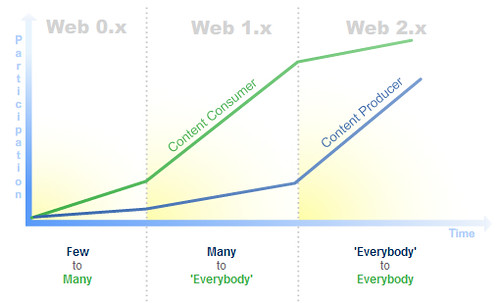Web 0.x to Web 2.0 Simplified
November 29th, 2005 by jeremychone | 7 Comments »This new excitement is probably generated by the presumption of achieving the ultimate Internet goal of enabling true “Everybody to Everybody” participation. However, while this “new wave” brings tremendous user and social values, it still does not seem to address some of the critical Internet roadblocks to pervasive Internet collaboration.
To better understand these limitations, we need to take a quick look at the evolution of the Internet. I see three main phases in the Internet evolution. (Note: The “Web x.x” numbering scheme is completely artificial, and is just used to support a “relative numbering” scheme leading to today’s “Web 2.0″ term).
- The Creation (“Web 0.x”): In the late mid `90s, the Mosaic project, created by Marc Andreessen, had the ambitious goal of making network collaboration accessible to the broadest audience possible. With the creation of Netscape Corporation, the idea attained tremendous visibility and support from the market, leading to the proliferation of a new client application allowing unfettered access to network information: The Internet browser.
- The Development (“Web 1.x”): The exponential growth in popularity of this new medium led established and new software companies to realize the great potential of this new market. On May 26, 1995, Microsoft, in a famous Bill Gates memo (“The Internet Tidal Wave“), reoriented itself towards this new model. Although the over-excitement created an inflated market that eventually burst, many content and service companies such as Yahoo!, Amazon, and eBay have remained strong and growing. The popularity of this new paradigm, coupled with the commoditization of the Browser on many devices, have put Internet in almost everybody‘s hands. This phase could be seen as the popularization of Internet access.
- The Reinvigoration (“Web 2.0″): Lately, infrastructure commoditization and the flamboyant success of new Internet companies, such as Google, have reinvigorated the drive for Internet innovation. I see two new fundamentals from the previous eras:
- First, the industry is now focusing on popularizing content publishing. New services like Blog (e.g. Six Apart), Wiki (e.g. Wikipedia), Photo Album (e.g. Flickr), Social Network (e.g. Linked In), and many others are based on the principle of enabling every users to become content producers as well as content consumers.
This “2 Way” web is already having important social ramifications, where knowledge and information are becoming more and more open and accessible. - Second, most of the Internet organizations are placing more emphasis on usage (direct or indirect via APIs) than subscribers (eyeballs). This is a great step towards building a stronger Internet in which closed Internet services, such as today’s Instant Messaging networks, will hopefully be pushed out of this ecosystem. It is always a great milestone when an industry understands that backing a larger cake might be more beneficial than trying to take a bigger piece of a smaller cake (see the Inherent Truths and Value of Community).
- First, the industry is now focusing on popularizing content publishing. New services like Blog (e.g. Six Apart), Wiki (e.g. Wikipedia), Photo Album (e.g. Flickr), Social Network (e.g. Linked In), and many others are based on the principle of enabling every users to become content producers as well as content consumers.
The following simple graph represents this evolution, where the “Web 1.x” phase is characterized by “content consumer” growth and the “Web 2.0″ phase by “content producer” growth.
 |
|---|
| Web 0.x to Web 2.0 Simplified |


 In the early days of the Internet, innovators and venture firms were equally important forces behind the internet evolution. At the time, most Internet ideas needed some external funding to get started. Consequently, ideas often started with the now infamous PowerPoint presentation to the VC. If ideas were accepted, most first round funds were devoted to building the proof of concept and generating enough buzz to acquire a user base. As a result, venture firms played key role in choosing which idea or group of people would start or not.
In the early days of the Internet, innovators and venture firms were equally important forces behind the internet evolution. At the time, most Internet ideas needed some external funding to get started. Consequently, ideas often started with the now infamous PowerPoint presentation to the VC. If ideas were accepted, most first round funds were devoted to building the proof of concept and generating enough buzz to acquire a user base. As a result, venture firms played key role in choosing which idea or group of people would start or not. Recently, users have been bombarded with new types of Web applications often referred to as "AJAX Applications." From an end-user point of view, these Web applications add a new level of interactivity, which was previously the domain of desktop applications.
Recently, users have been bombarded with new types of Web applications often referred to as "AJAX Applications." From an end-user point of view, these Web applications add a new level of interactivity, which was previously the domain of desktop applications.  In the last couple of weeks Microsoft has been pretty loud around the "new Internet wave." First, with the announcement of
In the last couple of weeks Microsoft has been pretty loud around the "new Internet wave." First, with the announcement of 


